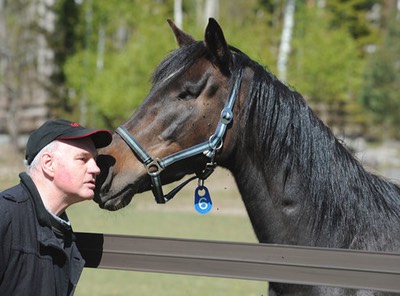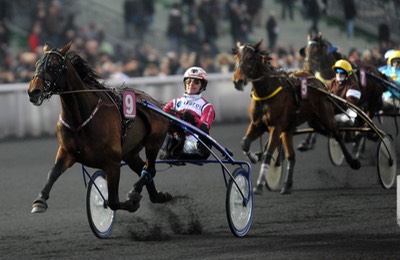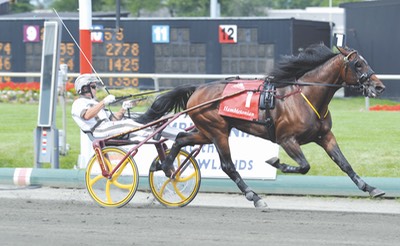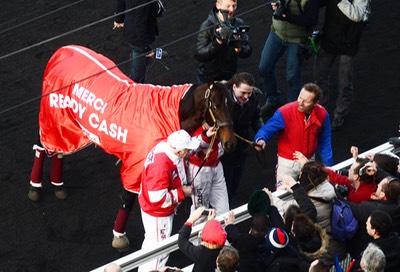"Online from Vienna, Austria, breedingtrotters.com proudly presents…"
by Ulf Lindström
About the statistics:
https://sulkysport.se/
mot-en-ny-championtitel/
Additional sources, open access:
https://sportapp.travsport.se/
sportinfo/horse
*Per July, 22, 2020. Small or
highly volatile
no of crops,
c. 20 or 5-30 born.
**SEK → $: ×0.113,
SEK → €: 0.097.
Numbers, no tricks: the statistics are in. Chocolatier is a sire of exceptional success with his small crops*, and we all regret the untimely passing of Joke Face. Armchair breeders are not holding their peace, however. Indeed, without the input from the self-appointed wizards of pedigrees, even the so-called ’old wives tales,’ something would be amiss in our community. Solid facts mixed with whataboutery, ifonlys, and far-flung hypotheses make us thrive, never mind if geneticists and economists consider this concoction high on externalities or just BS.
*
Your Highness,
sto, 1.09,7a – 9.216.927 kr
El Mago Pellini, 1.11,0am – 6.541.901 kr
Chelsea Boko,
1.10,2a – 6.055.269 kr
Inti Boko, 1.12,6 al – 5.898.000 kr
Drillbit Ås,
sto, 1.10,1a – 2.521.000 kr
Raffinos,
sto, 1.11,9a – 1.632.300 kr
Denim Boko,
sto, 1.10,7a – 1.562.055 kr
Is the Swedish community of breeders – world’s leading in terms of actually available bloodstock – at the forefront? Is it open-minded to new blood in the market of stallions? Looking back, the sires that made the 2020 half-time leaderboard were met with the usual response: skepticism and hoopla. Off the chart, blackballed stallions and those badmouthed after their first crop almost never return as come-back stallions.
For the ensuing analysis sires are paired based on basics: age and number of starts. What follows is like a gala night of boxing, with contenders in different weight-classes in virtual fights. Shoes off! A Victorian manual on etiquette is invoked to excuse ”one well-dealt blow settles the whole matter.”
As always, Love You, S.J.'s Caviar and Donato Hanover too had to confront uncertainty among the breeders about logistics and administrative red tape. Zola Boko, Quite Easy and Make It Happen rode the vawe of curiosity. Stallions draw customers also by being put up to serve the resident broodmare band at wellknown studs. Still, ”Book full and closed” are surprisingly rare in Sweden. Only on 17 occasions have a stallion among those 26 in the table above been booked with over 100 mares. Zola Boko’s spectacular debut is of human design. Of course, the live-foal fee too reflects on the records. Franco-American star Love You’s series after 2004 is indicative of overreach: 5-61-42-38-93-77-102-43-17-36-73-71-84-38-40-22. Mating is a question of genes, not nationality. Still, sire statistics and pedigree records travel badly across jurisdictions. Ingrained prejudice against French blood is slowly eroding in both the Nordic countries and the United States, Sebastian K and Ready Cash notwithstanding. Having said that, there’s an enigma asking for deep research: some sires and damsires are more or less successful across national borders for reasons that make no sense at all!
A long night ahead, the first bout is between the veterans.
Super Photo Kosmos vs Dream Vacation.
SPK got off with three future millionaires in his first crop 2003. Following a lull of four seasons he produced what turned out as fine earners in 2008-2011. Thirteen of his 19 millionaires are stallions/geldings. His career at stud bears the mark of his owner-promotor, 84 offspring with daughters by Scarlet Knight, three millionaires and counting. DV had a modest success with his first few crops only to turn out great talents in 2009-2011. DV equals SPK in 19 millionaires, three mares included. He sowed his oats liberally, with preference for mares by Muscles Yankee (27) and Coktail Jet (17) only to little avail. As this was the prologue of the night the crowd is pleased to announce a draw and the judges concur.
Chocolatier vs Going Kronos, American Winners!
Fans of the 1993 Hambletonian winner American Winner are treated to an invitational, represented by two of his renowned grandsons. In black trunks, C arrived in Sweden with a chip on his shoulder. His production was considered not up to American standards in early speed. Well, his answer to that was to sire future young winners, like the two who went on to bag the Kriterium, Sweden’s most prestigious stake for three-year-olds. Four of his 11 millionaires are mares. C’s many trysts with ladies out of Amour Angus’s line (43) turned out two star performers, twelve with Mack Lobell’s daughters two. GK, wearing bay trunks, entered the breeding business with fanfare. Indeed 2010 saw the birth of what turned out eight million-kronor earners! The following year produced five more, and he can still expect progeny to uphold his honor. Six of his 20 millionaires are mares. GK’s record of production with the Amour Angus line (29) has been disappointing so far. The judges call it a draw, and the industry sometimes wonders why these two sires have left few hoofprints in Swedish paddocks. Fertility and temperament issues, respectively, are issues of common knowledge. Then again, name one sire that was never attached with ’an issue’!
Raja Mirchi vs Joke Face, the Kolgjini Family’s Story.
Enters the Kolgjini family. RM had a glorious start in 2012 and is now expected to sire three or four millionaires out of each medium-sized crop. For now he prides himself with 15 millionaires, of which four mares. The Kolgjinis are true breeding buffs, as evidenced by the choice of damsires. We are now looking forward to the outcome of RM’s production with Chocolatier as damsire, 2018-19. Owners of broodmares by Pine Chip may consider RM next season: 4 of 28 cases are now millionaires. JF was at stud for only five seasons, unfortunate also because his crops were improving as racing prospects: Kolgjini’s U-crop now counts three millionaires out of 51 registered. Of the seven combined only one is a mare. She will be a much valued asset to the family’s breeding program, also as a pointer to other owners of mares by JF. A family affair, the judges prefer not to interfere in the domestic realm.
Make It Happen vs Andover Andover, mid vs low-budget choice.
Welcome and appropriate, low-budget options of stallions are necessary to the sport. Otherwise the starting fields shrink as we lose those who breed for keeps or are ready to let go of their yearlings at price under cost of production (c. 175,000 kronor). Soon enough the handle would plummet and the position of trotting in the community at large would follow south. AA, with a grade by the Stallion Board as ”very low potential” started off in 2009 with ”up yours”: his entire crop (2) turned millionaires! His production was minimal until 2011 when 51 foals hit the straw bedding. Sadly, none turned out poster material. Two years later it didn’t help with twice as many. AA’s four millionaires are all colts. Viking Kronos is the reasonable choice as damsire, two and soon three millionaires are announced. AA’s low-budget fee is confirmed by the wide maternal ancestry among his crops. MIH, whos first Swedish crop is born 2010, has produced two or three future million-kronor earners every year except 2012 out of medium-sized crops. Only one mare out of his 13 millionaires, though. MIH has had a thing going with Pine Chip’s ladies, so far with one million-success out 29 consummations (cf., Raja Mirchi’s four). MIH needs his three youngest crops, c. 190 combined, to outrank Andover Andover in terms of optional stallions in uneven fee categories.
French or Swedish, read Dubois vs Menhammar, is likely to become an amicable embrace in mutual respect for stamina and dedication to the industry.
Love You vs Maharajah, French and Swedish Delights.
Like earlier years the spring of 2003 had a fine collection of French stallions to select from. Not least Coktail Jet, with his finish in the 1996 Elitloppet in fresh memory. Sixty Swedish breeders could not resist, inspired also by the performance by Naglo the previous fall. It wasn’t until the second season available that LY equalled his father’s crop. Eight millionaires were in the making. Since then, despite variable bookings, records suggested that one out of ten was in reach of raking in a million in earnings. LY now counts 53, of which 11 mares. Fine, but get this: the best earners with French damsires – a mare with 3 million kronor to her credit, a gelding with a modest half a million – are ranked number 13 and 112 among his Swedish production. His average with French damsires is 121,000 kronor, or less than half that of American. LY’s French-registered offspring have French damsires, naturally. They have certainly not been duds, with c. 50 millionaires in kronor against one in Sweden! American, si vou plait: Lindy’s Crowns’ daughters have seven out of their 29 offspring by LY passing the million-kronor mark! Three are still young enough to be within reach, to up the average at 670,000 kronor in earnings. It looks as if Yankee Glide is a damsire of potential for LY’s remaining years, never mind the antiquated generation.
M had his first crop in 2013, when his best earner so far was born. His subsequent crops have varied between 40 and 100 products, leaving 7-10 millionaires each year and many more to enter this club. For now 11 of his 23 millionairs are mares. No golden crosses are evident. Pine Chip and his sons, together with damsires by the Valley Victory and Garland Lobell lines, still have to sort out who among them are the bearer of genes ahead to success. M and LY differ as to gender, in part due to the boosted purses for fillies and mares in Swedish racing. In sum, LY has 20, M 23 millionaires in their three first crops and M is set to see his five-year-olds putting LY further behind. Indeed, he is likely to widen the gap with a steadily improved broodmare material. LY is perhaps best served if provided with the mature broodmares. Well-read expertise may convince the owners that this is the end of the rainbow. The clocks are ticking at both ends. No verdict from the judges is expected.
”Ladies and gentlemen, in the blue corner, representing...”
Muscle Hill vs Ready Cash: The Fight of the Century!
October 1, 1975: "Ali slumped into his corner at the end of the 10th round exhausted and contemplated quitting." But, ”After further punishment in the 14th Frazier's trainer would not allow Joe to come out for the 15th.” Meanwhile, across the globe, Speedy Crown and Super Bowl had only just commenced their careers at stud, eventually to end close on par: 2,203 and 2,077 foals, respectively. Classic Families were to give Speedy Crown the nod by a hair’s breadth even though Super Bowl sired 15 and Speedy Crown 10 offspring racing 1:55 or faster.
MH had his first Swedish-born crop in 2011, 26 foals, of which two were to earn more than a million. Subsequent crops have counted about 60 foals. If at all in doubt, the crop of 2012, today counting 12 millionaires, confimed MH’s success at the tracks as well as sales in America. Presently he is good for 22 million-kronor earners, 5 mares, and many more likely to join the company. As for damsires, anything and nothing special seem to work with MH. Indeed, of damsires of reputation (Andover Hall,# Angus Hall, Cantab Hall, Credit Winner, Donato Hanover and Yankee Glide combined) 42 offspring born 2011-16 have turned out one millionaire!
RC had his first Swedish crop in 2010 with 24 foals. Three became millionaires. Later his crops have varied between 40 and 60. Today he has 39 millionaires to his record, with a flock waiting to qualify for that status. With 14 mares included this is all the more to his credit. Just as for MH RC has still to point us to a golden cross, merely hinting to Viking Kronos, Yankee Glide and – 261 Swedish-born ladies-in-waiting – Lindy Lane as damsires. ”Breed the best to the best and hope for the best.” Certainly, the advice was once put to effect in Sweden with 6 offspring by Speedy Crown out of Super Bowl mares and 11 of the reversed mating. The result? Two millionaires, one each and both mares. Still too young to confirm the deadpan advice, there are 11 Swedish-born of each combination of RC and MH.
The judges are in chambers, security standing by...while the crowd is filing out arguing over Muscle Hill or Ready Cash, some even comparing Manila, 1975...
Trixton vs Bold Eagle, Apples too do sometimes fall far from the tree…
Trixton’s first-born Swedish crop, 2016, has 49 numbers. One has already surpassed one million in earnings. Subsequent crops count 40 or 50 colts and fillies. Of the four-year-olds 40 out of 50 have entered races, of the three-year-olds 24 out of 43, with three millionaires, all fillies. All together the headstart for the girls is massive, 9.3 to 2.7 million kronor in earnings. Viking Kronos and Yanke Glide as damsires got off on a promising start. Bold Eagle too had his first crop of registered in Sweden in 2016, with 29 foals. One of them, a colt, has earned more than a million. His production grew apace to 60 offspring today. Of his four-year-olds 22 out of 29 have entered the races, of his three-year-olds only 14 out of 48 so far. Colts are doing the opposite of Trixton’s, out-performing their sisters by a collective 8.5 to 3.3 million kronor in collected purse money. As for damsires the available data so far do not hint to regularities. T and BE have had a fair shot as sires, what is now in store for the years ahead are of human design too: T will have to fight hard for the ladies with a platoon of MH stallions while many sons of RC will be bypassed in favor of BE. The Swedish-born crop of 2019 had sons of MH together producing 365 cousins, among at least 12 uncles: 61-3-18-7-21-51-39-4-20-92-23-26. Corresponding figures, with error margin, for RC read 239/11: 66-(25 sire of Swedish birth)-24-8-20-38-3-10-17-(26 sire of Swedish birth)-2. Swedish breeders and customers prefer to consider only two or three French stallions per season. Face Time Bourbon is ready for service. Furthermore, the live-foal fee for BE is substantially higher than that for T, to which also should be added the hassle of transportation and stabling of the select broodmares to BE.
This exercise is meant to be educational too, inspire the armchair breeders to provide documentation on the recurrent issues of:
1. The Gender Gap. The gap grows with age cohorts as mares are retired earlier than their brothers. The daughters of Up and Quick and Trixton are still only bleak hopes of equality in results in trotting. Meanwhile, Quite Easy will have to live with the label as sire of exceptional mares, confirmed at present with they earning a round million kronor more than the boys. Still, be careful with the comfort ”but his mares raced well.” This comment needs to be checked against the sire’s years at stud. The earlier the stallion is taken out of service the more likely his production ends with a balanced gender record.
2. The Nationality Gap. As to why some pedigrees are ”inexplicably” succesful in some jurisdictions, a few checks go toward accounting for the gap. The obvious is race conditions, variable distances. Second, the stakes programs regulate the development and campaigning of the bloodstock. Even if most owners appreciate early ROI, there is a streak of patience involved. Turnover of the racing material depends on the policy set by jurisdictions. Age and sex are finely tuned in France, less so elsewhere in Europe, least so in North-America. True, a ”war horse coefficient” across countries would be informative, i.e., the less geldings earn the heavier emphasis on breeding. Only the American stakes format is as much a boon to selective breeding as the French regime of discrimination of geldings and stallion grading by performance in group races.
3. The Siblings Gap. While available documentation suggests why full brothers score widely different with their crops – the brother who raced better also produced better – the enigma is still there. After all, the reverse records muddle the picture: sons of Flying Cloud, Ua Uka…
4. The Outcross Gap. This is perhaps overreacting on the recent Swedish performance of hybrids, the return of pacers to the big screen. Be that as it may, in addition to Zoot Suit’s fine contributions to the stock, Googoo Gaagaa and a few pacer dams are now reminding us of the times of Volomite (b 1926) as sire of dual gaited progeny.
5. The Human Gaps – or why,
after 1849, the horses and mares were not left to themselves and their
business. To what extent and consequence the owners of the sire, broodmare band
etc., enter the picture, perhaps also as trainer of the offspring. Or, to recall
Mr Bob Boni’s Pferdanschauung, ”I
like to think of one that was a disappointment at racing as a star performer if
he or she had had a different trainer.”
#Another mystery: Andover Hall as damsire
compared, Sweden and globally, respectively:
https://sportapp.travsport.se/sportinfo/horse/ts685124/offspring?origin=swedish&vintage=all&gender=all&grandpa=ts568973&limit=all
https://www.classicfamilies.net/CF/ClassicCrosses.aspx?HorseID=10050568
2020_09





